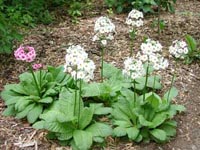Resource Library
Plant of the Week: Primrose, Candelabra or Japanese
The University of Arkansas System Division of Agriculture does not promote, support or recommend plants featured in "Plant of the Week." Please consult your local Extension office for plants suitable for your region.
Plant of the Week
Candelabra Primrose, Japanese Primrose
Latin: Primula japonica

Gardeners share a love of the natural world and are always excited to learn about new plants and new gardens. On Nov. 5, gardeners in the northwest Arkansas area will have the opportunity to do both when Scottish nurseryman and plant explorer Jim Jermyn discusses new and interesting plants of Japan. One of his special interests is primroses. One of my favorite primroses is Primula japonica, the Candelabra Primrose.
The candelabra primrose is a large primrose, as primroses go. It produces the normal basal rosette of leaves, but in this species the leaves can grow up to a foot long. The cabbage-like leaves are an unobtrusive light green with an herbaceous character, dying away with first freezes of winter.
In the spring, the leaves reappear and in late April, erect spikes of flowers bloom. The flowering stem can reach two feet in height if plants are grown in a sunny bog, but in my irrigated shade garden they grow from 16 to 18 inches tall. The blooms are borne in three to six clusters around the lengthening flower scape, creating a kind of upside down candelabra. Blooms are white, red or pink and about an inch in diameter; plants remain effective in the garden for two to three weeks.
Primroses are a diverse group of plants with more than 400 species. They have a reputation for being somewhat difficult to grow, but until I’ve killed a plant at least three times, I refuse to give up on it. With Japanese primrose, I was surprised to find how easy it is to grow and how well it has performed in my garden.
Jermyn will be telling us about groovy plants to grow in the rock garden. He will be speaking at 11 U.S. cities and throughout Canada under the sponsorship of the North American Rock Garden Society. The Ozark Rock Garden Society and the U of A Department of Horticulture are sponsoring his Fayetteville visit.
Jermyn is an internationally recognized authority on Asian plants. His most recent book is an account of plants from the high Himalayas and how to grow them in the garden. For 20 years he managed one of the United Kingdom’s premier rock garden nurseries, Edrom Nurseries (see to view some of the plant gems they grow) where he won many awards at the various flower shows held in Scotland and England. He now lives in Berwickshire, Scotland and lectures widely in Europe and the United States.
The talk will be at 7 p.m. in the Plant Science Auditorium on the UofA campus. It's free and all are welcome. The Plant Science building is on Maple Street, just to the north of Old Main. Free parking is available in the various University lots, several of which are located one block north of Maple Street.
Japanese primrose is not commonly available in local nurseries. I grew my plants from seeds obtained from the Rock Garden Society. Of the various primroses I have grown, it is probably the easiest to grow from seed. Plants flower a year after seeding. In its native habitat, Japanese primrose is a bog plant but it seems to grow well in shaded areas that can be watered during the summer. Incorporate plenty of organic matter into the bed prior to planting. For most effective display, crowd the plants in at about eight inch spacing to create a mass display.
By: Gerald Klingaman, retired
Extension Horticulturist - Ornamentals
Extension News - October 24, 2003
The University of Arkansas System Division of Agriculture does not maintain lists of retail outlets where these plants can be purchased. Please check your local nursery or other retail outlets to ask about the availability of these plants for your growing area.